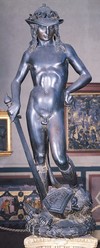Early Renaissance Italy Flashcards

Nanni di Banco, Four Crowned Saints, 1408-14 (Or San Michele, Florence, Italy), marble
Patron saints of stonemason guild- early Christians who refused to carve pagan statue under Dicoletian- executed and martyred
individualized in appearance (Renaissance vs. Int’l Gothic)- far R appeard to be speaking, hand raised- forced to look at each other in tight space- psychological cross-referencing; drapery- heavy, weighty, naturalistic
appreciate antiquarianism- interest in objects from (Roman) antiquity- mimic forms and techniques (e.g. in beards, hair)

Masaccio, The Holy Trinity, 1428 (Tomb Domenico- Lenzi family, Florence)
one of the most important works in the history of art
introduces linear perspective-mathematical system whereby suggest 3-D space on 2-D surface- here- one-point linear perspective- basis of how viewing angles constructed in West (vanishing point [eye line of viewer], horizon line, orthogonals)
buon fresco- wet lime plaster
subject is Holy Trinity in fictive burial chapel, Christ, Gof the Father, Holy Spirit as dove, VM looks out, St. John the Evangelist, donors kneel
stable pyramidal composition, apex= most important figure- most common in early, high Renaissance
Nod to classical architecture, Corinthian and ionic capitals, fluted pilasters, Roman arches, vault with coffered ceilings

Filippo Brunelleschi, Church of San Lorenzo, designed 1434
1st truly Renaissance church design- modular design using 3-D unit of space at crossing, repeats throughout
result is mathematical harmony/everything equals everything else; e.g. nave height=column height
unity of interrelated components vs. verticality (Gothic)

Donatello, David, late 1420s-late 1450s
1st free standing nude since antiquity
originally for Medici courtyard- private audience- nudity not yet okay in public; nude because does not need Saul’s armor- God will protect; decapitated head of Goliath at feet
symbol for Florentine republic- small but righteous
contrapposto pose; figure closed physically & psychologically (contemplating miracle), yet erotic; intended to be seen from multiple viewing angles

Antonio Pollaiuolo, Battle of Ten Nudes, 1465
largest Florentine engraving of 15th century- 24” across- four copper plates
copied throughout Europe- intertwined figures in superimposed registers from Roman sarcophagi- bodies engaged in mortal combat
no narrative function- figures repeated in different poses to show virtuosity of artist illustrating musculature/anatomical detail
used as reference for many artists

Sandro Botticelli, The Birth of Venus, 1482
one of the most famous paintings in art history- west wind Zephyrus blows nude Venus to shore of island of Cypress, clothed by nymph Pomona
tempera on canvas- good for opaque detail- would have been ceremonial wedding procession banner
pose derived from antiquity- Venus pudica- covers genitals yet draws attention to them
exaggerated contrapposto pose, proportions exaggerated by sinous line= poetic; event as allegory of birth and beauty in human mind
Horace- “Ut pictora poesis”= “As poetry, painting”- painting is mute poetry, power of illustration of written word- power of God’s words


